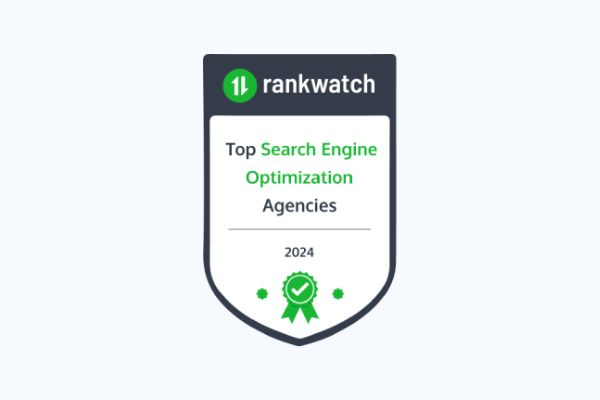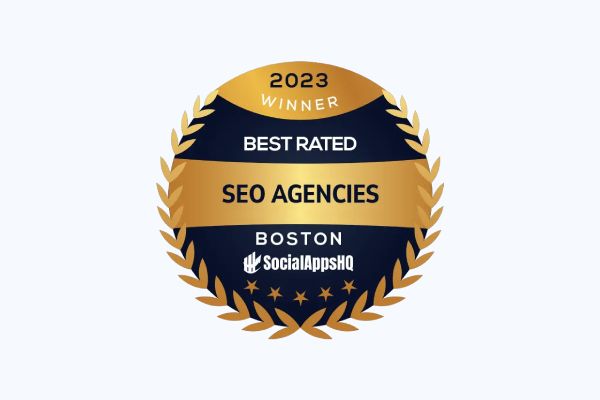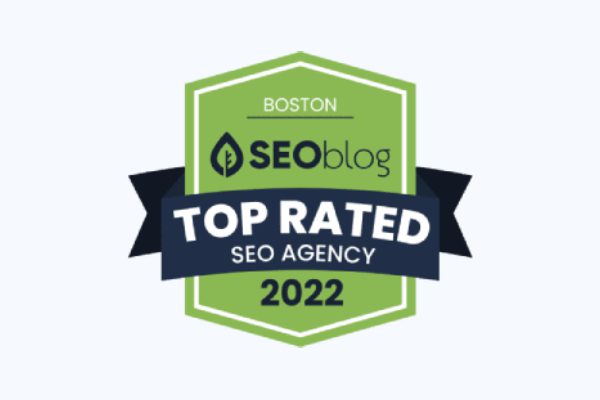If you’re wondering where should you put your digital marketing budget for this year, look no further than your MUST-have monster SEO checklist for 2024. It’s not too hard to figure it out. In 2020, organic search traffic grew to 53%. That’s a huge number considering that only 15% of traffic comes from paid search (BrightEdge). But your SEO efforts aren’t worth much if you don’t do it right. Consider that the #1 position in Google’s search engine results pages (SERPs) gets more than a quarter of clicks, whereas position #10 gets a measly 2.5% (Search Engine Journal).
There’s no question that SEO is perhaps the digital priority, so how are you doing? Well, everyone wants to do better. To help your SEO efforts pay off, we’ve created this exclusive SEO Checklist of “must-do” items for 2024.
Visual Objects Names us #3 SEO Agency and #1 Social Media Agency in Boston
There are quite a few areas to pay attention to for your SEO Checklist for 2024, so we’ve broken things down into these categories:
- Technical elements
- On-Page Content elements
- Keywords
- Analysis Reporting and Integration
- Social Media
- Monthly Website Check-In
Technical Elements for your SEO Checklist for 2024
There are many technical elements in your website that affect search engine results. They generally fall into several categories: Those which affect indexing and those which affect user experience. Some technical situations are easier to fix than others. Some CMS systems like WordPress will fix many problems without you even knowing it. Plugins like Yoast will help avoid other technical problems. Some items can be resolved on the front end and others require back-end resolution. Fortunately, there are many free and paid tools that can provide relatively painless remedies for most problems.
- Create an SEO-friendly URL structure: URL structures that are simple, descriptive, and keyword-rich helps both crawlers and users quickly figure out what the page is about. Too many URLs that point to identical or similar content on your site may lead to incomplete indexing.
- Remove irrelevant parameters in the URL: Look for ways to remove lots of numbers, letters, and symbol characters that make URLs hard to read or understand.
- Submit and optimize your XML Sitemap: Make sure you have submitted an XML sitemap to Google. This provides all of your site’s URLs and overall site structure for indexing. Learn more here.
- Optimize the robot.txt file: Your robot.txt file tells search engine robots how to crawl and index your website. It prioritizes pages, plus it says which pages or files web crawlers can or can’t request from your site.
- Use structured markup (schema): Structured data code helps search engines give users more informative, context-based results. For example, instead of just providing an article, schema can relay helpful information for users, such as author and date.
- Find and fix broken 4xx errors: We all know the dreaded 401 “dead link” error code. Other 4xx errors indicate additional “client error responses” that negatively impact SEO. Find 4xx errors and fixes using your Google Search Console, free tools such as Xenu, or paid tools such as HootSuite.
- Find and fix 3xx errors: These “redirect error codes” indicate that the client has requested information that is no longer at the provided address. The fix requires updating the target URL or removing the link altogether.
- Find and fix other HTTP status errors: Fix other HTTP status errors in the 100s (information responses) and 500s (server errors). Status in the 200s indicates a successful response. Here’s a good cheat sheet to find out more.
- Move from HTTP to HTTPS protocol: If your website uses the HTTP protocol, migrate it to the HTTPS protocol. HTTPS, which uses a superior encryption process, is a Google ranking factor.
- Remove duplicate websites: You may unknowingly have multiple live versions of your site. Examples include duplicate versions at “www.yoursite.com” and “yoursite.com,” or duplicate versions using HTTP:// and HTTPS://. Your developer can fix this with a “canonical tag,” which defines the preferred version.
- Provide links to or from orphaned pages: If pages on your site aren’t linked to or from at least one other page, Google flags it as ‘orphaned pages in sitemaps‘. These pages are not indexed and can’t be searched by crawlers. Automated “crawling” tools such as Screaming Frog and Deep Crawl will find these pages for you.
- Update your page experience: Google wants your website to be user-centric, which it measures with a combined set of symbols. These include Google’s Core Web Vitals, mobile-friendliness, safe-browsing, HTTPS-security, and intrusive interstitial guidelines.
- Speed Improvements: Loading speed is a highly important ranking factor. Google’s free PageSpeed Insights tool provides diagnostics and suggestions for faster loading. Key suspects for slow loading times include your hosting service, large image sizes, unused CSS code, and too many ads.
Website Updates that Will Yield Big Results: 10 No-Brainer Fixes for Your Website
On-Page Content Elements
Google is continuously updating its search algorithm to provide the most relevant, high-quality content for users. As a result, SEO has become less about specific keywords and more about user experience. A common acronym used to describe what Google looks for is E-A-T, which stands for Expertise-Authority-Trustworthiness. The result is that high-quality content that provides a good user experience is best for SEO. The following areas will improve your E-A-T score with Google and should be included in your Monster SEO Checklist for 2024.
1. Remove outdated content: Old posts, which may provide incorrect information, can cause your credibility and traffic to suffer. Also, having too many pages on the same topic (using the same or similar keywords) can lead to “keyword cannibalization.” This means you’re competing with yourself for ranking on a Google search, and usually, both pages will rank lower.
2. Make keywords more like speech: Google’s December Core Update makes use of AI to better understand the searcher’s intent and meaning. For example, Google now looks at synonyms. Also, instead of focusing on a single “primary” word in the search, it considers words that provide context (such as “to” and “for”). This indicates that long-tail keywords may perform better.
3. Display properly all devices: People may be looking at your content on their smartphone, desktop, or laptop. Make sure your website design displays properly on each type of device. This free Google tool lets you check out how a page displays on mobile.
4. Adjust design based on device preference: Mobile searches now account for over half of all searches. Studies show that users scan pages differently on mobile devices versus desktops. For better engagement, designers may want to adjust page layout (such as CTA placement) based on the devices that are most popular among their visitors. Find out more here.
5. Prepare for voice search: Voice search is increasingly prevalent. As a result, more and more searches are full sentences and questions, rather than short phrases or word groupings. This has made long-tail keywords increasingly important. A second effect is on local search (where is a restaurant near me?). For example, instead of using “Italian restaurant Boston,” try “where is an Italian restaurant in Boston” as your keyword phrase.
6. Chunk information: People tend to scan information, rather than read straight through, to get the gist of the content and find the specific information they need. Chunking information is critical. Use short paragraphs of several sentences, subheads every few paragraphs, bullet points, graphics, and other techniques to break up blocks of text.
7. Improve SEO titles: Title tags (aka search titles) are the blue clickable titles on SERPs. Google will truncate your title if it is too long, which can reduce click-throughs. Here are some tips:
- Use your content management system (such as WordPress) or a plugin like Yoast, create your own title rather than rely on Google to create its own.
- Duplicate (or nearly identical) page titles are bad for SEO. Make sure each page’s SEO title is unique.
- Use keywords in your page or article title.
9. Improve meta descriptions: Meta descriptions, also called snippets, are the short paragraphs under to SEO title. They should clearly summarize the content of your page. Keep snippets under 160 characters to avoid truncation. When possible, provide your own snippet rather than rely on Google’s version (often just the first part of the first paragraph). Also, put search words early in your meta description.
10. Use just one H1 tag per page: The H1 tags refers to the page title that users see (not the SEO title). More than one will confuse Google’s understanding of the page and indexing.
11. Intersperse H2 headings: H2 headings should be used at least every few paragraphs to separate large blocks of text. They should be in a logical order for scanning and the contents under each subhead should relate directly to the subhead.
12. Optimize images and video files: Files that are too large slow down loading time. JPEG, GIF, and PNG format each have their own profile for performance, file size, image quality. Unless there a reason to use a large file, stick with a small file format and use tools to condense images, such as Optimizilla and TinyPNG. You can get a short overview of each format here.
13. Use Image alt tags: Provide image alt tags, which describe your image and can include keywords. These tags help Google “see” your image and also improve user experience for those with visual disabilities.
14. Improve content readability: This is a meaty topic, so here are some pointers:
- Use short words, sentences, and paragraphs.
- Avoid large blocks of uninterrupted text.
- Make good use of white space and images.
- Pay attention to the flow and structure of the page.
- Proofread carefully to avoid careless errors.
- Use fonts that are easy to read and large enough.
- Don’t go crazy with elements like fonts and colors.
- Answer common questions in your content for AI-based search
1. Improve pages that have thin content:
Google defines thin content as pages that “have little to no value for users. According to Search Engine Journal, this type of content includes duplicate content, scraped content, auto-generated content, invaluable affiliate pages, or doorway pages. In addition to these types of thin content, try to make each page have at least 300 words.
Keyword Strategy as a Part of your SEO Checklist for 2024
- Conduct SEO Research: This is a huge topic on its own. Keyword research can uncover queries to target, the popularity of these queries, their ranking difficulty, and more. Many tools can help with this research, including free tools. These include Google keyword planner, the ahref Keyword Generator, and Wordstream’s keyword tool. You can also check out the competition with SpyFu.
- Set SEO keyword goals: This is a natural fallout of your keyword research. Your goals will be based on your unique selling proposition (USP), the benefits of what you offer, how you solve customers’ problems, audience intent and likely search terms, your competitors’ search terms, and other factors.
- Create a keyword map: This is a great way to start setting keyword goals. Identify both your “pillar” keywords. These are your high-value, highly competitive terms. Also select your subtopic keywords that will be easier to rank on, often long-tail keywords. Map these words to pages on your site and identify any gaps. This framework will mirror your site’s structure, optimize content, and help you identify which topics are most popular.
- Optimize keyword locations: Make sure to use your keywords (and synonyms) in the right places, including:
- Page titles
- Landing pages
- Title tags
- H1, H2, and H3 header tags
Improve for voice search:
Current statistics show that 41% of adults use voice search at least once per day. Studies show that in 2020, more than half of all smartphone users will engage with voice technology on their devices. Look at how users ask questions. Use keywords that sound like questions that users would ask using natural language, such as “How do I improve SEO on my website?”
Analytics Reporting and Integration
You have taken all the steps needed to boost your SEO for 2020, but how do you know if your hard work has paid off? How do you know if you should continue what you’re doing or change it up? You won’t be able to answer these questions without an analytics tool. Luckily there are many to choose from, including many free ones to add to your SEO Checklist for 2024.
- Set up your Google search console: This free tool from Google helps track your performance in Google searches. It shows you a range of metrics, including the number of clicks and impressions, which keywords are bringing the most traffic, bounce rate, pages per session, website errors to fix, and more.
- Learn and use Google Analytics 4: Connecting Google Analytics 4 with your Google Search Console provides more SEO data from Google. You’ll learn about your audience, acquisition, behaviors, conversions, and more. With the upgrade to Universal Analytics in 2023, privacy laws have changed the way Google presents data so you might need some other tools too to get a better picture of things.
- Learn about Your Competitors: Understanding your competitors’ strategies and results can help you beat them at their own game. You can get free tools, or free versions of paid tools including Google Trends, BuzzSumo, and SpyFu. Learn data such as where your competitors are mentioned on the web, the source of competitors’ traffic, and the demography of its audience.
Social Media is a pertinent part of your SEO Checklist for 2024
- Update social media channels: Make sure your social media channels are up-to-date and review the quality and content of your posts.
- Keep a schedule and Post regularly: You’ll find it easier to post regularly by having a plan (see below) about where to post, how often, and relevant topics (which may change based on the season or specific events).
- Manage your social media content: There are a plethora of tools to help you plan, manage, and automate social media posting. Popular paid tools include Hootsuite and Buffer. You can also download free spreadsheets, such as HubSpot’s Social Media Content Calendar Template and the Sprout social calendar.
- Analyze your social media channels: Make sure you have the right tools in place to understand which tactics and strategies are working, and which aren’t. This will help you spend your time and budget wisely. Popular tools include Google Analytics, Hootsuite Analytics, and Keyhole. You can also use tools provided by the platform itself, such as Facebook Insights and LinkedIn Analytics.
- Manage your Google My Business Listing wisely: Businesses tend to not pay much attention to their Google My Business (GMB) Profiles, but local searches always display companies that meet the search criteria on GMB at the top, before any Ads or Organic Results.
Your Monthly Website SEO Check-In
A monthly check-in will help you track results and refine your strategies. Further, they will keep the quality of your website from degrading over time. You don’t need to revisit each of the areas above each month, but keeping on top of the key items below will keep you in tip-top shape as part of your SEO Checklist for 2024:
- Update your plugins and WordPress software: Your website CMS and apps are regularly updated by their developers for functionality and, perhaps more importantly, to fix security gaps. Check that you are using the latest version.
- Review your analytics: Do your analytics tell you what you need to know? Check that your digital goals and the metrics you’re using are aligned.
- Look at traffic by location: If you have a local business, make sure you’re drawing traffic from the right area. National or international businesses can measure if their traffic and location of paying customers are aligned.
- Analyze your landing page traffic: Find out if the traffic you receive is landing on your most important pages, such as the products you want to highlight. Also, identify the most popular blog posts to find out which topics resonate.
- Identify spikes in traffic: Find out what you posted on days when you get spikes in traffic. This will indicate how you can grow traffic.
- Check your referral traffic: Identify which websites are sending traffic to your website so you can work on building positive business relationships and explore new opportunities to better engage with your audience.
- Evaluate quality and frequency of new content: If you can’t do a full review, spot-check new content for consistency and quality.
- Update calls-to-action: Remove any CTAs that are outdated and see if any are missing or should be moved.
- Update Events: Make sure all upcoming events are promoted and old ones are taken down.
- Check for Broken Links: Broken links are just plain bad. Try this free Broken Link Checker.
- Update local promotion: Update (or sign up for) your Google my Business, Yelp, and other sites that expose your business to your local audience.
https://www.ladybugz.com/googles-december-2020-core-update-for-seo/
Getting your website’s SEO up to speed
There are so many ways you can boost your SEO in 2024, some of which are more complex than others and some which are more time-consuming than others. What’s certain is that the more items on this list that you can check off, the better position you’ll be to get more organic traffic and conversions.
If you want to kick SEO into high gear, we recommend utilizing this monster SEO Checklist for 2024…









